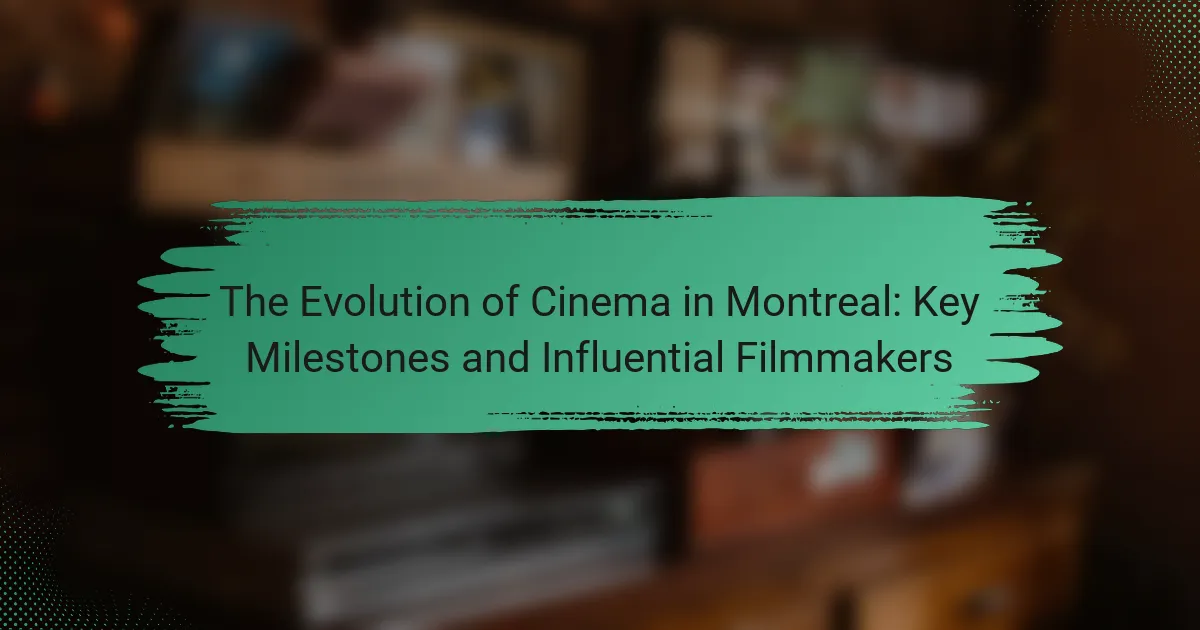The article examines the evolution of cinema in Montreal, highlighting key milestones and influential filmmakers that have shaped the city’s film landscape. It begins with the establishment of the first permanent cinema in 1906 and traces Montreal’s growth as a film production hub through the 1920s. The creation of the National Film Board of Canada in 1939 and the cultural renaissance of the 1960s and 1970s are significant developments discussed, along with the emergence of notable filmmakers such as Denys Arcand and Gilles Carle. The article also covers the founding of the Montreal World Film Festival in 1977 and the city’s current status as a center for diverse film festivals and international productions, supported by a vibrant arts scene and favorable film incentives.

What is the evolution of cinema in Montreal?
The evolution of cinema in Montreal reflects its rich cultural history and artistic development. The first permanent cinema opened in Montreal in 1906, marking the city’s entry into the film industry. By the 1920s, Montreal became a hub for film production, supported by local studios and theaters. The National Film Board of Canada was established in 1939, promoting Canadian cinema and showcasing local talent.
In the 1960s and 1970s, the city experienced a cultural renaissance, leading to the rise of influential filmmakers like Denys Arcand and Gilles Carle. The Montreal World Film Festival was founded in 1977, further solidifying the city’s status in the global film community.
In recent years, Montreal has become known for its diverse film festivals, such as the Fantasia International Film Festival and the Montreal International Documentary Festival. The city continues to attract international productions, thanks to its vibrant arts scene and attractive film incentives.
How did cinema begin in Montreal?
Cinema began in Montreal in the late 19th century. The first public screening of films occurred in 1896. This event featured short films from the Lumière brothers. The introduction of motion pictures captivated local audiences. Early cinemas, known as nickelodeons, emerged soon after. These venues offered affordable entertainment to the public. By the early 1900s, Montreal became a hub for film production. Notable studios, such as Famous Players, established operations in the city. This laid the foundation for Montreal’s vibrant film industry.
What were the first films produced in Montreal?
The first films produced in Montreal include “The City of the Future” and “The Great Train Robbery.” “The City of the Future” was created in 1897 by the Lumière brothers. “The Great Train Robbery,” released in 1903, was influential and showcased early narrative filmmaking. These films marked the beginning of Montreal’s film industry. The city became a hub for innovation and creativity in cinema shortly after.
What role did local theaters play in the early cinema scene?
Local theaters were essential in the early cinema scene. They served as primary venues for film screenings. These theaters introduced audiences to moving pictures. They showcased short films and feature-length movies. Many local theaters were equipped with projection technology. This allowed them to host regular film showings. Theaters also helped in building a local film culture. They provided a space for community engagement with cinema. Local theaters often featured live performances alongside films. This combination attracted diverse audiences and increased attendance.
What key milestones have shaped Montreal’s cinematic landscape?
Montreal’s cinematic landscape has been shaped by several key milestones. The establishment of the National Film Board of Canada in 1939 marked a significant development. This organization promoted Canadian storytelling through film. The launch of the Montreal World Film Festival in 1977 showcased international cinema. This festival helped elevate Montreal’s status as a cultural hub. The emergence of influential filmmakers like Denys Arcand and Xavier Dolan also contributed to the city’s cinematic identity. The growth of the local film industry has been supported by tax incentives since the 1990s. These incentives attracted numerous productions to the city. Collectively, these milestones have defined Montreal’s vibrant film culture.
Which historical events significantly influenced the film industry in Montreal?
The establishment of the National Film Board of Canada in 1939 significantly influenced the film industry in Montreal. This organization promoted Canadian cinema and supported filmmakers. The Montreal Expo 67 also played a crucial role by showcasing films to a global audience. Additionally, the emergence of the Cinémathèque Québécoise in 1963 preserved and promoted Quebec’s film heritage. The rise of the independent film movement in the 1990s further diversified the Montreal film scene. These events collectively shaped Montreal’s identity as a vibrant film hub.
How did the establishment of film festivals impact local filmmakers?
The establishment of film festivals significantly benefited local filmmakers. Film festivals provided a platform for local talent to showcase their work. They facilitated networking opportunities with industry professionals. Local filmmakers gained access to audiences that may not have seen their films otherwise. Festivals often included workshops and panels, enhancing filmmakers’ skills. Increased visibility led to potential funding opportunities for future projects. Statistics indicate that local films showcased at festivals often receive distribution deals. This has contributed to a more vibrant local film industry overall.
Who are the influential filmmakers from Montreal?
Influential filmmakers from Montreal include Denys Arcand, Xavier Dolan, and Philippe Falardeau. Denys Arcand is known for his Academy Award-winning film “The Barbarian Invasions.” Xavier Dolan gained international acclaim with films like “Mommy” and “Heartbeats.” Philippe Falardeau directed the Oscar-nominated “Monsieur Lazhar.” These filmmakers have significantly shaped the cinematic landscape of Montreal. Their works reflect diverse themes and styles, contributing to the city’s reputation as a hub for innovative cinema.
What are the notable works of Montreal filmmakers?
Notable works of Montreal filmmakers include “Incendies” by Denis Villeneuve. This film received an Academy Award nomination for Best Foreign Language Film. Another significant work is “Mommy” by Xavier Dolan, which won the Jury Prize at the Cannes Film Festival. “The Decline of the American Empire” by Denys Arcand is also notable, as it was nominated for an Academy Award for Best Foreign Language Film. These films showcase the talent and creativity of Montreal’s film industry. They reflect diverse themes and innovative storytelling techniques, contributing to the global cinematic landscape.
How have these filmmakers contributed to the global cinema landscape?
These filmmakers have significantly influenced the global cinema landscape through innovative storytelling and unique cultural perspectives. They have introduced diverse narratives that resonate with international audiences. Their works often blend local themes with universal messages, enhancing cross-cultural dialogue. For instance, filmmakers from Montreal have won prestigious awards at global festivals, showcasing their artistic merit. This recognition has helped elevate Canadian cinema on the world stage. Additionally, their contributions to film techniques and genres have inspired filmmakers worldwide. They have also fostered collaborations that bridge cultural gaps, enriching the global film industry.
How has the technology of filmmaking evolved in Montreal?
Filmmaking technology in Montreal has significantly evolved over the decades. Initially, the industry relied on traditional film cameras and analog techniques. The introduction of digital filmmaking in the late 1990s marked a major shift. This transition allowed for easier editing and reduced production costs. By the 2000s, high-definition cameras became widely accessible. The rise of computer-generated imagery (CGI) transformed visual storytelling. Local studios began adopting advanced post-production technologies. Today, Montreal is a hub for innovative filmmaking techniques, including virtual reality and 3D animation. The city’s film industry continues to embrace new technologies, enhancing creativity and production quality.
What advancements in film technology have been adopted in Montreal?
Montreal has adopted several advancements in film technology, including digital filmmaking and virtual reality. The city has embraced high-definition digital cameras, which enhance image quality and production efficiency. Additionally, Montreal’s film industry utilizes advanced editing software like Avid Media Composer and Adobe Premiere Pro. The integration of visual effects technology has also progressed significantly, with studios employing tools such as Autodesk Maya and Nuke. Furthermore, virtual reality experiences are being developed, showcasing immersive storytelling techniques. These advancements position Montreal as a leading hub for innovative film production in Canada.
How has the shift to digital filmmaking affected local productions?
The shift to digital filmmaking has significantly impacted local productions by reducing costs and increasing accessibility. Filmmakers in Montreal can now create high-quality films with lower budgets. Digital technology allows for easier editing and distribution. This shift has led to a rise in independent films. According to a report by the Quebec Film and Television Council, local productions have increased by 30% since the adoption of digital formats. Filmmakers can experiment with new storytelling techniques due to the flexibility of digital equipment. Additionally, local talent has gained more opportunities to showcase their work. Overall, digital filmmaking has democratized the production process in Montreal.
What cultural influences have shaped cinema in Montreal?
Montreal’s cinema has been shaped by diverse cultural influences, including French, English, and Indigenous heritage. The city’s bilingual nature fosters a unique blend of storytelling traditions. French cinema has significantly impacted local filmmakers, promoting artistic expression and narrative styles. English-language films also contribute, reflecting North American cultural themes. Additionally, Indigenous perspectives are increasingly represented, enriching the cinematic landscape. Festivals like the Montreal International Film Festival celebrate this cultural diversity. The city’s vibrant arts scene further encourages collaboration among filmmakers from various backgrounds. These elements collectively define Montreal’s cinematic identity.
How do Montreal’s diverse communities reflect in its films?
Montreal’s diverse communities are prominently reflected in its films through varied narratives and cultural representation. Films often showcase the multilingual nature of the city, highlighting English, French, and immigrant languages. This linguistic diversity enriches storytelling and character development.
Cinemas in Montreal frequently depict the experiences of different ethnic groups. For example, films like “Incendies” explore themes of identity and cultural heritage. The presence of filmmakers from various backgrounds contributes to this representation.
Montreal’s festivals, such as the Montreal International Film Festival, celebrate films that focus on multiculturalism. These events provide a platform for underrepresented voices.
Overall, Montreal’s film industry acts as a mirror to its rich tapestry of communities, fostering understanding and dialogue through cinema.
What role does bilingualism play in the film narratives produced in Montreal?
Bilingualism plays a significant role in the film narratives produced in Montreal. The city is a cultural hub where both French and English languages coexist. This linguistic duality influences storytelling, character development, and dialogue in films. Many filmmakers incorporate bilingual characters to reflect the city’s diverse population. Bilingualism allows for richer narratives that resonate with a wider audience. Films often explore themes of identity and belonging through language. This dynamic enhances the authenticity of the narratives. The presence of bilingualism in Montreal’s cinema reflects the city’s unique cultural identity.
What are the future trends for cinema in Montreal?
Future trends for cinema in Montreal include increased investment in local productions. The city is becoming a hub for diverse storytelling. Technology such as virtual reality is gaining traction in film experiences. Additionally, there is a growing emphasis on sustainability in filmmaking. The rise of streaming platforms is influencing local distribution methods. Collaborative projects with international filmmakers are on the rise. Emerging filmmakers are exploring innovative narratives and formats. Finally, audience engagement through interactive cinema is expected to grow.
How are emerging filmmakers shaping the next generation of Montreal cinema?
Emerging filmmakers are reshaping the next generation of Montreal cinema through innovative storytelling and diverse perspectives. They are pushing boundaries by incorporating unique cultural narratives. Many of these filmmakers are influenced by the city’s rich multicultural background. Their works often reflect contemporary social issues, resonating with younger audiences. Film festivals in Montreal, such as Fantasia and RIDM, showcase their projects. These festivals provide platforms for new voices and experimental formats. The rise of digital technology has also enabled greater accessibility for these filmmakers. This shift allows for lower production costs and wider distribution opportunities.
What challenges does the Montreal film industry face moving forward?
The Montreal film industry faces several challenges moving forward. One significant challenge is competition from other film markets. Cities like Toronto and Vancouver offer attractive incentives that can draw productions away from Montreal. Another issue is funding limitations. Many local filmmakers struggle to secure financing for their projects. Additionally, the industry must adapt to technological advancements. The rise of streaming platforms changes audience viewing habits and production needs. There is also a need for diversity and inclusion within the industry. Underrepresented voices require more opportunities to tell their stories. Lastly, the impact of the COVID-19 pandemic has created lingering uncertainties. Productions are still navigating health protocols and audience engagement post-pandemic. These challenges require strategic solutions to ensure the industry’s growth and sustainability.
What tips can aspiring filmmakers learn from Montreal’s cinema history?
Aspiring filmmakers can learn several valuable tips from Montreal’s cinema history. The city has a rich cinematic legacy that emphasizes storytelling and cultural diversity. Filmmakers should focus on authentic narratives that reflect local experiences. Montreal’s film industry showcases the importance of collaboration among artists. Networking within the community can lead to innovative projects. Filmmakers can also draw inspiration from the city’s unique blend of languages and cultures. This diversity can enhance creativity and broaden audience appeal. Additionally, studying the works of influential Montreal filmmakers can provide insights into unique styles and techniques. Understanding the evolution of the industry in Montreal can help filmmakers navigate their own careers effectively.
The main entity of the article is the evolution of cinema in Montreal, which encompasses its historical development, key milestones, and influential filmmakers. The article outlines the inception of cinema in Montreal, starting with the first permanent cinema in 1906, followed by the establishment of significant institutions like the National Film Board of Canada in 1939. It highlights the cultural renaissance of the 1960s and 1970s, the rise of notable filmmakers such as Denys Arcand and Xavier Dolan, and the impact of local film festivals on the industry. Additionally, the article discusses technological advancements in filmmaking, the influence of Montreal’s diverse communities on cinema, and the future trends and challenges facing the local film industry.


